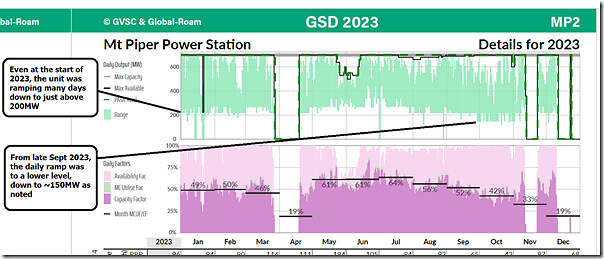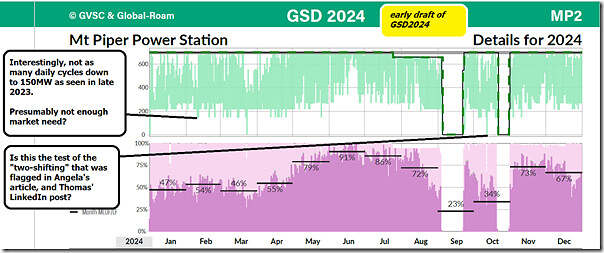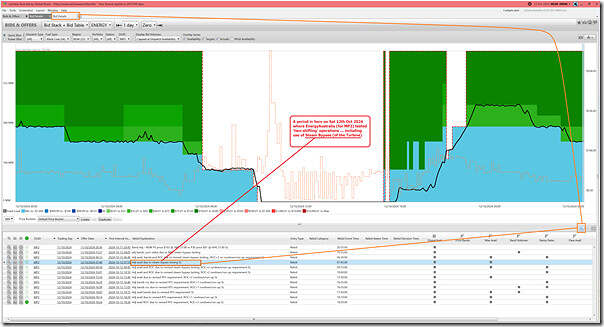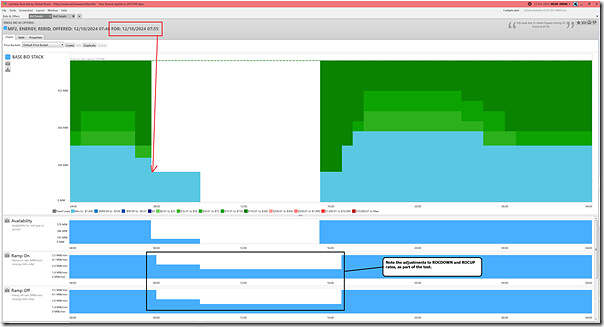Amongst the flurry of news articles we noticed in the pre-Christmas rush was the article ‘EnergyAustralia’s fight for future of NSW coal plant’ by Angela MacDonald-Smith in the AFR on Tuesday 17th December 2024.
The full & lengthy article is well worth reading (for those who have subscribed for access), but the following excerpt is what I wanted to focus on here:
‘The flexibility built into the two Mount Piper turbines from the start has been increased over the years given the transformation wrought in the market by cheap renewables. Originally able to be ramped down to 320MW, the turbines’ minimum operating level reached 150MW 18 months ago.
EnergyAustralia has gone further, trialling a process where a turbine is taken off the grid altogether for up to 12 hours, but the boiler is kept warm and ready to fuel the turbine when it comes back on. That process, traditionally known as “two-shifting”, came from plants in the UK and the US needing to cope with a very different daily cycle.’
We saw this noted at various places on social media, including:
1) Thomas MacDonald (from Aurecon) noted it here in his update on LinkedIn … in which he wrote:
‘We noticed what looked suspiciously like a two-shift trial of Mount Piper #2 back on the 12th of October, shortly after the widely reported trial on Bayswater #4 on the 9th of September. This now suggests it was the real deal, and continues to build the argument that coal’s future on the NEM (or at least in NSW) may be substantially more flexible than many had assumed.’
… note that on 1st October we’d written about ‘AGL’s successful completion of the first two-shifting trial for Bayswater unit 4 (on 7th September 2024)’.
2) Antony Stace (from SwissRE) also noted this in his update on LinkedIn.
What do we see, from the Generator Statistical Digest?
Given that it’s January 2025, we’ve commenced the number crunching to produce the next update in the annual production of the ‘Generator Statistical Digest’ … with the next cab off the rank being the GSD2024:
1) With data to 31st December 2024 … stretching back to 1st January 2015 (or from whenever the unit started operations, if more recently)
2) That we aim to have released as soon as possible after the Australia Day long weekend (i.e. from Tuesday 28th January 2025).
Only yesterday, our team produced another iteration of a ‘not-for-dissemination early draft’ of the document, which now stands at 1357 pages (up from 1194 pages in the GSD2023). I thought I’d start by grabbing the ‘Daily Output’ chart for Mt Piper unit 2 for both documents in order to see what’s visible at that helicopter view in terms of changing operations at this particular unit.
Daily operating range through calendar 2023 in the GSD2023
Here’s the excerpt for the relevant chart from the GSD2023:
As noted on the image:
1) Even from the start of 2023 (and possibly earlier) we see many days where the unit was ramping down to just above 200MW:
(a) Lest anyone misinterpret what Angela wrote in the AFR above:
i. the ‘minimum stable generation’ level did not drop from 320MW to 150MW in one single step change.
ii. the unit has been made increasingly flexible over several steps.
(b) Reviewing offline with ez2view, we see that this ramp was often as low as 220MW.
2) We can see that, from late September 2023, the operating range was extended to allow the unit to operate stably down at 150MW, as Angela noted in her article.
So let’s take a similar look at 2024…
Daily operating range through calendar 2024 in the (early draft of the) GSD2024
Here’s the equivalent view from the (early draft of the) GSD2024:
With this image, we see:
1) Not so many daily cycles down to 150MW as seen in the period in 2023 from September and October:
(a) presumably in part because there was testing going on in 2023;
(b) but also (presumably) because of insufficient market need*.
* readers should understand that (we presume that) the heat rate of the unit (i.e. its efficiency) would be worse at lower load, so the incentive for the unit would be to run as efficiently as possible, subject to market price outcomes.
2) There’s also a single daily cycle down to 0MW identified in October 2024, which is presumably what Thomas referred to in his note above?
Let’s dig further….
What do we see, from ez2view?
For more detail, we open up ez2view and (utilising the ‘Bids & Offers’ widget time-travelled back to October 2024) take a look at Saturday 12th October 2024 (which was as can be seen in these collated articles also a day where the AEMO were forecasting MSL1 in Victoria):
We see that:
1) From the rebid reasons (several on the day) we see that this test was performed with the use of steam bypass (i.e. of the turbine), which would be* one approach to enabling the boiler to remain fired (and hence steam superheated) to allow for faster return-to-service.
* if my engineering memory of steam cycles in coal fired power stations is not too rusty!
2) As part of the testing process, load was first reduced down to the 150MW minimum generation level noted above, before coming offline completely**.
** readers should take note that by ‘completely’ here we mean that:
(a) The output of the unit was 0MW through the period 10:20 through until 16:00 (NEM time) on the day.
(b) This was achieved by the turbine and generator being offline (i.e. bypassed) ….
(c) But important to note that, in this case, the boiler remained fired and at temperature, with steam at-temperature and cycling.
Using the magnifying glass on the highlighted rebid, we can see more details here:
With this image we see:
1) This particular rebid took effect from the 07:55 dispatch interval (NEM time) … which was the dispatch interval at which the availability was dropped to 150MW as part of the process of coming offline.
2) Note also the reduction in both ROCDOWN and ROCUP rates, as part of the test.
Increasing requirement for flexibility of coal units, and ability to respond, will be something of increasing interest to a number of readers … as such we’ll be publishing more articles here under the ‘Increasing flexibility from coal’ category heading
… including drawing on the soon-to-be-released GSD2024!






Looking forward to your analysis on the benefits Gentailers get, two-shifting their scheduled assets and the effect on the value of independent retailer contract positions.
As Australia’s push for net zero is looking increasingly unlikely (and too expensive), the prospect of extended use of coal should go way beyond trying to 2shift large coal fired units that were never designed for this purpose – progress to much smaller capacity units that can be more suited to allow dominance of solar power when available. These should not be high tech supercritical units, but basic design – with the cheaper fuel costs, super high efficiency should not be an issue (it never was in the coal fired units on which we still rely). What politicians will have the courage to go down this track – not the current mob! Best regards